The Apple iPad Pro Review
by Ryan Smith, Joshua Ho & Brandon Chester on January 22, 2016 8:10 AM ESTBattery Life
Battery life is important beyond any doubt. No one wants a tablet or phone that can only spend three hours away from a charger before it dies, no matter how good the device is. While such battery life might be incredible for a desktop replacement or anything else that realistically spends most of its life plugged into a charger, mobile devices are usually carried on the go and used far away from a charger for significant amounts of time. Probably the ultimate example of this is travel, where one might use a tablet to watch movies and browse the internet for a few hours over the course of a flight.
As a result, a significant portion of our reviewing efforts are devoted to determining battery life. In order to quantify battery life, there are inevitably a lot of test cases to cover. Some people might spend most of their time in an e-reader app, others might spend most of their time playing games or similarly intensive tasks on their phones. There’s no real standard for usage, so a tablet that might last a day for one person could last a week. As a result, the goal of our testing is to provide a useful relative comparison. In order to do this, we attempt to equalize for variables like display brightness by setting all displays to 200 nits for battery life testing. Due to the inability to completely eliminate the variables that come with live network testing, we also use strong network reception with high throughput on LTE to ensure that things like power amplifiers are either at a low power setting or bypassed entirely.
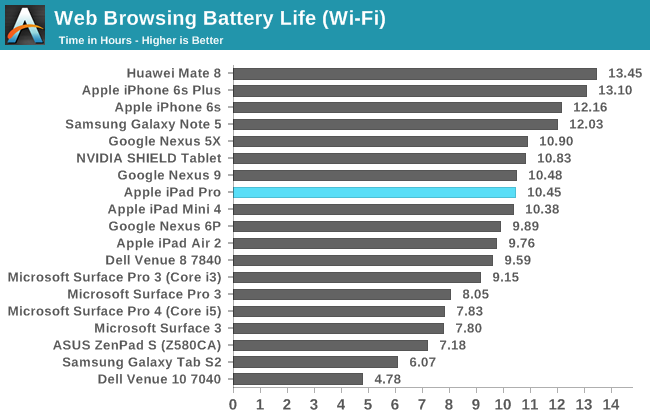
Our first test is the venerable web browsing test, in which we load a selection of web pages from full charge until the device shuts off from lack of battery charge. In WiFi battery life is pretty much identical to the iPad Air 2, which might be surprising given that the battery is only 41% larger. That might sound like a lot, but the display of the iPad Pro is 77% larger at the same 264 PPI pixel density, which means that there’s a pretty sizeable efficiency gap between the iPad Air 2 and iPad Pro. The improved display and SoC are likely to be the main reasons for this, as the 20nm SoC process that was used to make the A8 SoC was quite leaky due to its traditional planar transistor structure compared to the FinFET process used in the A9X.
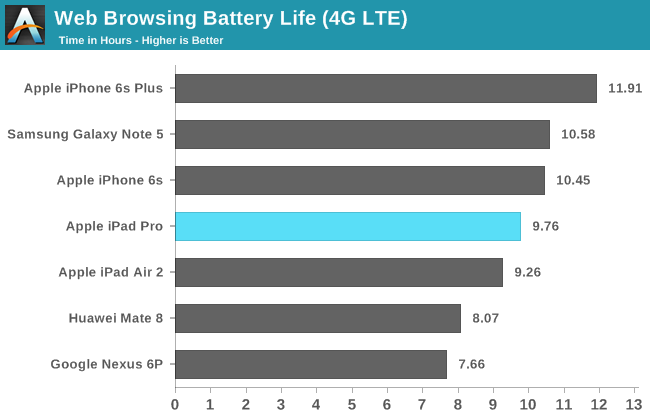
Interestingly, for whatever reason when re-running the same test on LTE battery life is noticeably different when compared to the iPad Air 2, where LTE and WiFi battery life were relatively close. I suspect that RF power is pretty similar between the two devices, but due to efficiency improvements on the display/SoC side the difference in battery life due to additional RF power consumption is magnified.

The more interesting test result that I encountered over the course of battery life testing was our tablet video rundown test. For whatever reason, web browsing clearly lasts a decent amount longer. It's pretty unlikely that the web browser has a lower SoC load when video is basically entirely dependent upon fixed function hardware decode. The most plausible explanation here for me is that we're seeing differences that arise from panel self-refresh, which can kick in on our web browsing test while the same definitely doesn't hold for our video test, which basically requires at least 30 FPS refresh rate continuously for the entire duration of the test. Overall that this makes the iPad Pro worse for content consumption, given Apple's content creation goals, is an unexpected turn of events.
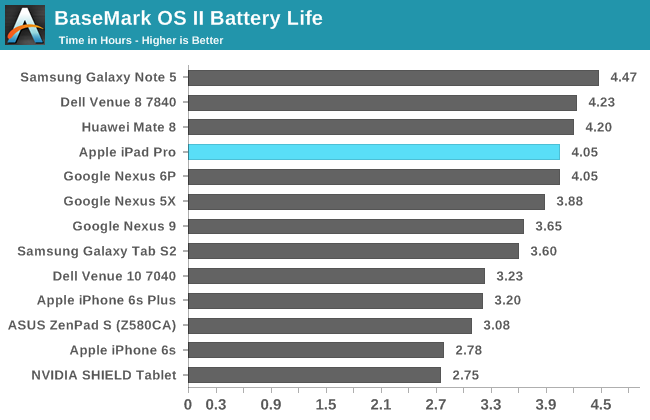
Moving on to the more SoC-bound tasks, we can start by looking at Basemark OS II, which is basically a CPU power virus that can be used to examine the upper bound for device TDP, in addition to nominal sustained CPU load. It’s evident from this test and some back of the envelope calculation that total device TDP excluding display power is roughly 5W, which is about right given the size of the device. This suggests that the A9X can be directly compared to Intel’s Core M in both performance and power, for better or for worse. Performance here is good, with relatively low throttling due to the use of a FinFET process and solid implementation of the Twister architecture.

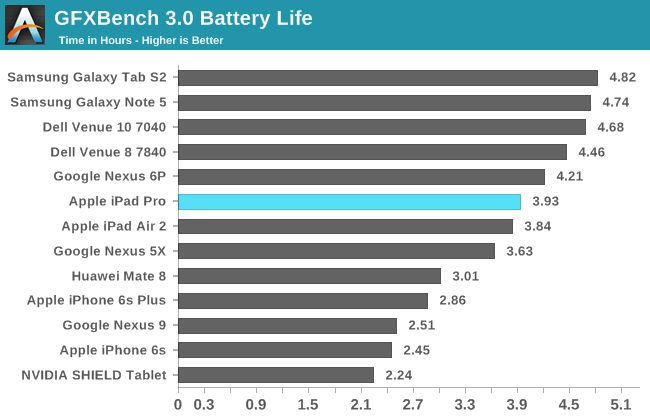
In our GPU throttling test, the A9X has effectively made it impossible to actually use T-Rex as a throttling test as it’s essentially pegged at vsync for the entire duration of the test. The iPad Pro also lasts a similar amount of time here as on the Basemark OS II test, which suggests that this test is still reaching TDP limits for the GPU, even if it doesn't manifest in the form of reduced performance.
Charge Time
While battery life is important, any time you’re dealing with a mobile device the time it takes to charge the battery is important as well. The usual example here is travel, but simply forgetting to plug in a device overnight can show the importance of charge rate. In the case of the iPad Pro, Apple ships it with their usual 12W charger. One might be tempted to suggest that the battery would be charged in about 3.5 hours, but it’s necessary to get the data and avoid speculation on something like this. In order to test how quickly the iPad Pro charges, we measure the difference in time between first plugging in a fully discharged tablet and when the charge is complete based upon power draw at the AC adapter.
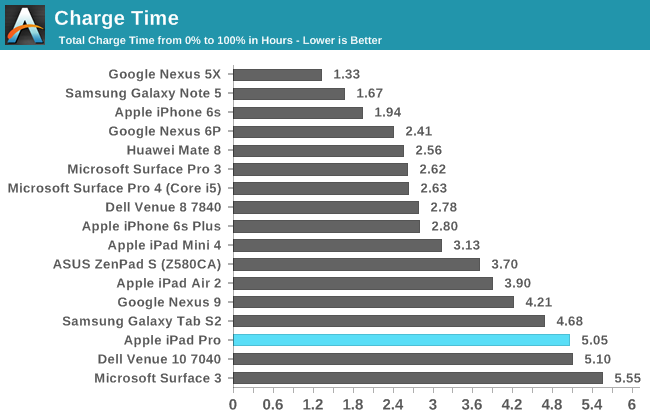
Interestingly, the iPad Pro takes a pretty significant amount of time to charge, at over a full hour longer than the iPad Air 2. While some might be okay with this, it’s definitely a sore spot for the iPad Pro as a higher voltage charger would be able to charge the device at a more acceptable rate. I’m not really sure why Apple decided to go this route, but there’s really no clear solution here unlike the case of the iPhone 6s Plus. The charger also definitely isn’t enough to ensure that you’re always charging the iPad Pro while in use either if the SoC is in overdrive/turbo states as thermally constrained power draw is already around 9-10W.
Despite the long charge time, overall the iPad Pro is quite mobile. However, it does regress somewhat relative to the iPad Air 2 due to its longer charge time, even if battery life is equivalent. Depending upon your use case though it might be difficult, if not impossible to tell the difference.











408 Comments
View All Comments
AirunJae - Wednesday, February 10, 2016 - link
Notice he said nothing about the iPad being better than the Surface, just that "...stop being a Fanboy" and "Surface Pro 4 wins" is ironic because you're following you plea for the reviewers (I assume) to stop being fanboys with some fanboyism of your own.MaxIT - Saturday, February 13, 2016 - link
Not running Windows make it better by definition....Delton Esteves - Wednesday, February 17, 2016 - link
Are you out of your mind? Not running full OS makes it worstdarwiniandude - Monday, February 29, 2016 - link
"Full OS"Drivers. Malware. Compatibility issues (install old piece of software, have it break new software). No low latency audio, audio not a priority. Any decent software is designed for mouse and keyboard, not tablet interface. For my purposes Surface is a waste of space. In fact we recently bought used a Surface 2 256GB for $100. Owner thought it was faulty. Wifi didn't work. Touch screen didn't work. Trackpad didn't work. Everything looked fine with the software config except there was malware. Wiped and reset up, works fine. But I can't use it for anything because the software I want to run isn't on Windows. The tablet ecosystem is elsewhere. Windows store is a joke. So it sits gathering dust.
Alecgold - Friday, February 12, 2016 - link
You've written a lot of BS.There is lighting to USB, so what is your point?
Lighting to hdmi adapter is available as well..
Lighting to memory card (with usb-3 speeds) is available
Kickstand is build in in the keyboard or smartcover.
Not everybody needs a pen, so why include it?
I don't need USB, HDMI, SD-cards or kick stands.
So why include it if you don't need it?
Keyboard is expensive indeed, but it's really good...
Who needs backlit, at night you need to sleep
I'm really annoyed by the trackpad on the surface, doesn't work when I want to, does work when I don't want to
Function keys are on the screen if needed or can be swiped up, not as convenient, but I prefer the small depth of the keyboard.
Why would I need to rest my hand? It rests on the table I'm writing on.
Setup was really fast an easy, what is complicated?
The iPad is a tablet so therefore it runs a mobile os, it has great battery life, I can do everything I need to. I just can't OCR PDF's, that is the only thing I still miss.
I'm a professional a consultant, I can do everything I need to, so there it is, it's used by a professional and therefore an iPad Pro. Just as good reasoning as yours, I guess.
Is the iPad Pro for anybody? Absolutely not. It's expensive, others need more processing power or bigger/better/more complete software. But if you can get by with it, I t's really a good device and a really good experience!
Delton Esteves - Wednesday, February 17, 2016 - link
Lighting to USB, lighting to hdmi adapter and lighting to memory card will cost you extra.The Kickstand which was built in the keyboard is very difficult to set up and has limited positions.
"Not everybody needs a pen". This is not a reason to charge for extra money.
Despite you do not need usb, hdmi, it does not mean they cannot include it. Because a device is made having in mind the general needs and not a single person needs.
You call yourself a Professional and yet you say "Who needs backlit". It seems like everybody has a definition of a Pro device this days.
So you always write on a table?
Writting and tapping on the screen is tiresome, function keys make you more productive.
Constructor - Saturday, February 20, 2016 - link
It is an illusion to believe that "included" items were in any way "free". In fact, for most people they would only pay more for stuff that they'd never use.On the bottom line everybody would have to pay more and there would be more electronic waste. Only the few people who actually used those add-ons might(!) get away slightly cheaper. That's it.
Delton Esteves - Tuesday, February 23, 2016 - link
But at least, they are not charging extra. If you consider Ipad Pro price you will notice that it is already expensive for what it is and what the majority of its Users will use it for. They are charging a lot for zero extra functionality.Constructor - Tuesday, February 23, 2016 - link
I have paid a little more for my iPad Pro than for my iPad 3 four years ago, and the iPad Pro is again a much better tablet than the iPad 3 had been (and it was already a very good one!).And I have paid extra for the Pencil which I actually wanted to use. Other users left the Penicl out and didn't have to pay for it. It's that simple and the way it should be.
So what exactly is the problem supposed to be with me paying for what I want to use, and others not paying for what they don't want to use? That's a really weird mindset from my point of view.
Delton Esteves - Wednesday, March 9, 2016 - link
They should lower Ipad pro price because Apple Pen does not come with it